Precomputed Radiance Transfer (Direct3D 9)
Using Precomputed Radiance Transfer
There are several forms of complexity present in interesting scenes, including how the lighting environment is modeled (that is, area lighting models versus point/directional ones) and what kind of global effects are modeled (for example, shadows, interreflections, subsurface scattering.) Traditional interactive rendering techniques model a limited amount of this complexity. PRT enables these effects with some significant restrictions:
- Objects are assumed to be rigid (that is, no deformations).
- It is an object-centric approach (unless objects are moved together, these global effects are not maintained between them).
- Only low-frequency lighting is modeled (resulting in soft shadows.) For high-frequency lights (sharp shadows), traditional techniques would have to be employed.
PRT requires either of the following, but not both:
- highly-tessellated models and vs_1_1
- ps_2_0
Standard Diffuse Lighting versus PRT
The following illustration is rendered using the traditional (n · l) lighting model. Sharp shadows could be enabled using another pass and some form of shadowing technique (shadow depth maps or shadow volumes). Adding multiple lights would require either multiple passes (if shadows are to be used) or more complex shaders with traditional techniques.
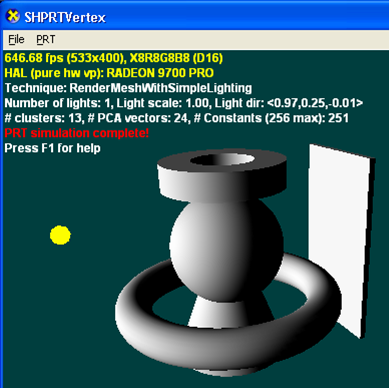
The next illustration is rendered with PRT using the best approximation of a single directional light that it can resolve. This results in soft shadows that would be difficult to produce with traditional techniques. Because PRT always models complete lighting environments adding multiple lights or using an environment map, you would only change the values (but not the number) of constants used by the shader.
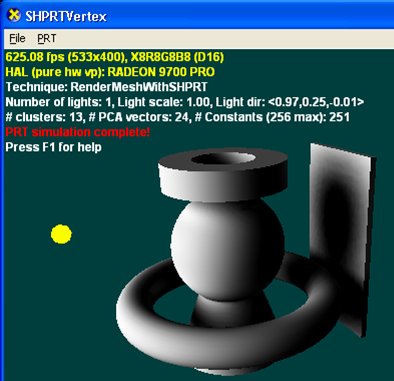
PRT with Interreflections
Direct lighting reaches the surface directly from the light. Interreflections are light reaching the surface after bouncing off some other surface some number of times. PRT can model this behavior without changing the performance at run time by simply running the simulator with different parameters.
The following illustration is created using direct PRT only (0 bounces with no interreflections).
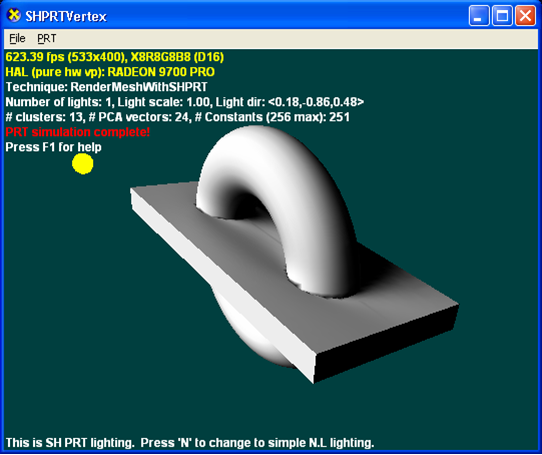
The following illustration is created using PRT with interreflections (2 bounces with interreflections).
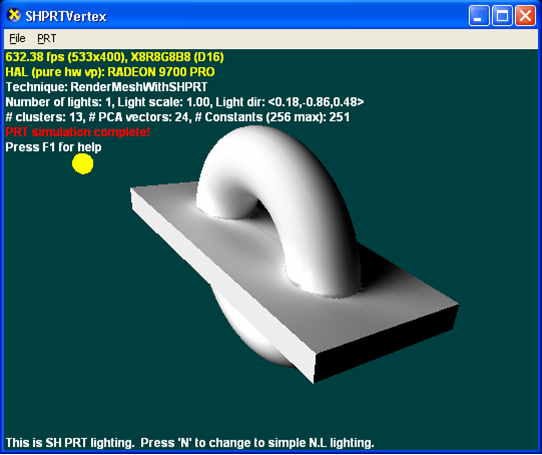
PRT with Subsurface Scattering
Subsurface scattering is a technique that models how light passes through certain materials. As an example, press a lit flashlight against the palm of your hand. The light from the flashlight passes through your hand, bounces around (changing color in the process), and exits from the other side of your hand. This can also be modeled with simple changes to the simulator and no changes to the runtime.
The following illustration demonstrates PRT with subsurface scattering.
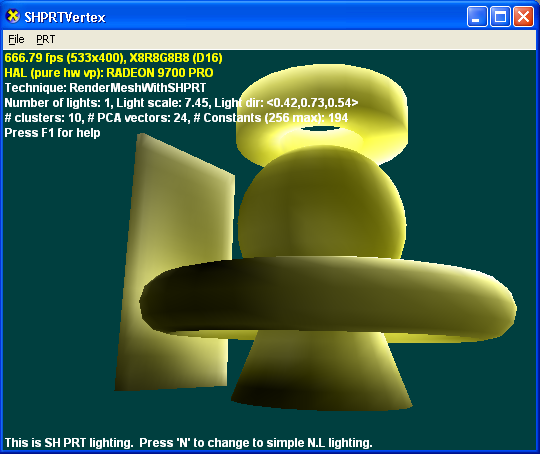
How PRT Works
The following terms are useful for understanding how PRT works, as illustrated in the following diagram.
Source Radiance: The source radiance represents the lighting environment as a whole. In PRT an arbitrary environment is approximated using the spherical harmonic basis - this lighting is assumed to be distant relative to the object (the same assumption that is made with environment maps.)
Exit Radiance: Exit radiance is the light leaving from a point on the surface from any possible source (reflected radiance, subsurface scattering, emission).
Transfer Vectors: Transfer vectors map Source Radiance into exit radiance and are precomputed offline using a complex light transport simulation.
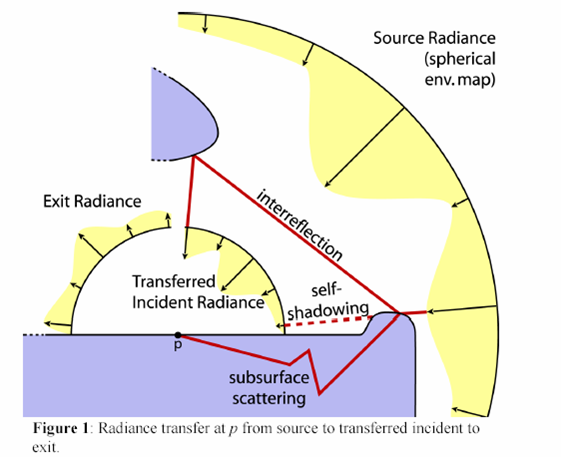
PRT factors the rendering process into two stages, as shown in the following diagram:
- An expensive light transport simulation precomputes transfer coefficients that can be used at run time.
- A relatively lightweight run-time stage first approximates the lighting environment using the spherical harmonic basis, then uses these lighting coefficients and the precomputed transfer coefficients (from stage 1) with a simple shader, resulting in exit radiance (the light leaving the object).
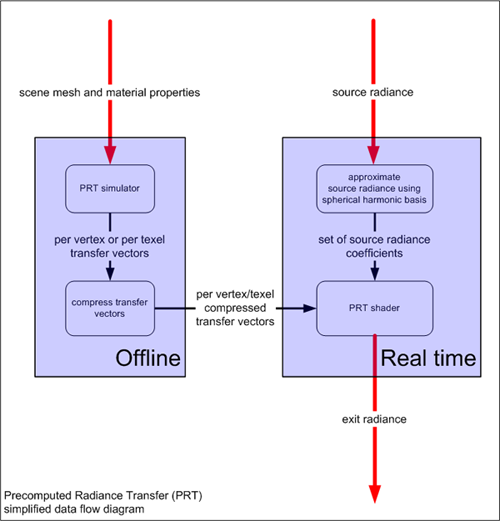
How to Use the PRT API
Compute the transfer vectors with one of the Compute... methods of ID3DXPRTEngine.
Directly dealing with these transfer vectors requires a significant amount of memory and shader computation. Compression significantly reduces the amount of memory and shader computation required.
The final lighting values are calculated in a vertex shader that implements the following compressed rendering equation.

Where:
Parameter Description Rₚ A single channel of exit radiance at vertex p and is evaluated at every vertex on the mesh. Mₖ The mean for cluster k. This is an Order² vector of coefficients. k The cluster ID for vertex p. L' The approximation of the source radiance into the SH basis functions. This is an Order² vector of coefficients. j An integer that sums over the number of PCA vectors. wpj The jth PCA weight for point p. This is a single coefficient. Bkj The jth PCA basis vector for cluster k. This is an Order² vector of coefficients. The Extract... methods of ID3DXPRTCompBuffer provide access to compressed data from the simulation.
Compute the source radiance.
There are several helper functions in the API to handle a variety of common lighting scenarios.
Function Purpose D3DXSHEvalDirectionalLight Approximates a conventional directional light. D3DXSHEvalSphericalLight Approximates local spherical light sources. (Note that PRT only works with distance lighting environments.) D3DXSHEvalConeLight Approximates a distant area light source. An example would be the sun (very small cone angle). D3DXSHEvalHemisphereLight Evaluates a light that is a linear interpolation between two colors (one on each pole of a sphere). Compute the exit radiance.
Equation 1 now has to be evaluated at every point using either a vertex or pixel shader. Before the shader can be evaluated, constants have to be precomputed and loaded into the constant table (see the PRT Demo Sample for details). The shader itself is a straightforward implementation of this equation.
struct VS_OUTPUT { float4 Position : POSITION; // vertex position float2 TextureUV : TEXCOORD0; // vertex texture coordinates float4 Diffuse : COLOR0; // vertex diffuse color }; VS_OUTPUT Output; Output.Position = mul(vPos, mWorldViewProjection); float4 vExitR = float4(0,0,0,0); float4 vExitG = float4(0,0,0,0); float4 vExitB = float4(0,0,0,0); for (int i=0; i < (NUM_PCA_VECTORS/4); i++) { vExitR += vPCAWeights[i] * vClusteredPCA[iClusterOffset+i+1+(NUM_PCA_VECTORS/4)*0]; vExitG += vPCAWeights[i] * vClusteredPCA[iClusterOffset+i+1+(NUM_PCA_VECTORS/4)*1]; vExitB += vPCAWeights[i] * vClusteredPCA[iClusterOffset+i+1+(NUM_PCA_VECTORS/4)*2]; } float4 vExitRadiance = vClusteredPCA[iClusterOffset]; vExitRadiance.r += dot(vExitR,1); vExitRadiance.g += dot(vExitG,1); vExitRadiance.b += dot(vExitB,1); Output.Diffuse = vExitRadiance;
References
For more information about PRT and spherical harmonics, see the following papers:
Precomputed Radiance Transfer for Real-Time Rendering in Dynamic,
Low-Frequency Lighting Environments
P.-P. Sloan, J. Kautz, J. Snyder
SIGGRAPH 2002
Clustered Principal Components for Precomputed Radiance Transfer
P.-P. Sloan, J. Hall, J. Hart, J. Snyder
SIGGRAPH 2003
Efficient Evaluation of Irradiance Environment Maps
P.-P. Sloan
ShaderX 2, W. Engel
Spherical Harmonic Lighting: The Gritty Details
R. Green
GDC 2003
An Efficient Representation for Irradiance Environment Maps
R. Ramamoorthi, P. Hanrahan
A Practical Model for Subsurface Light Transport
H. W. Jensen, S. R. Marschner, M. Levoy, and P. Hanrahan
SIGGRAPH 2001
Bi-Scale Radiance Transfer
P.-P. Sloan, X. Liu, H.-Y. Shum, J. Snyder
SIGGRAPH 2003
Fast, Arbitrary BRDF Shading for Low-Frequency Lighting Using Spherical
Harmonics
J. Kautz, P.-P. Sloan, J. Snyder
12th Eurographics Workshop on Rendering
Precomputing Interactive Dynamic Deformable Scenes
D. James, K. Fatahalian
SIGGRAPH 2003
All-Frequency Shadows Using Non-linear Wavelet Lighting Approximation
R. Ng, R. Ramamoorth, P. Hanrahan
SIGGRAPH 2003
Matrix Radiance Transfer
J. Lehtinen, J. Kautz
SIGGRAPH 2003
Math World
E. W. Weisstein, Wolfram Research, Inc.
Quantum Theory of Angular Momentum
D. A. Varshalovich, A.N. Moskalev, V.K. Khersonskii
Related topics